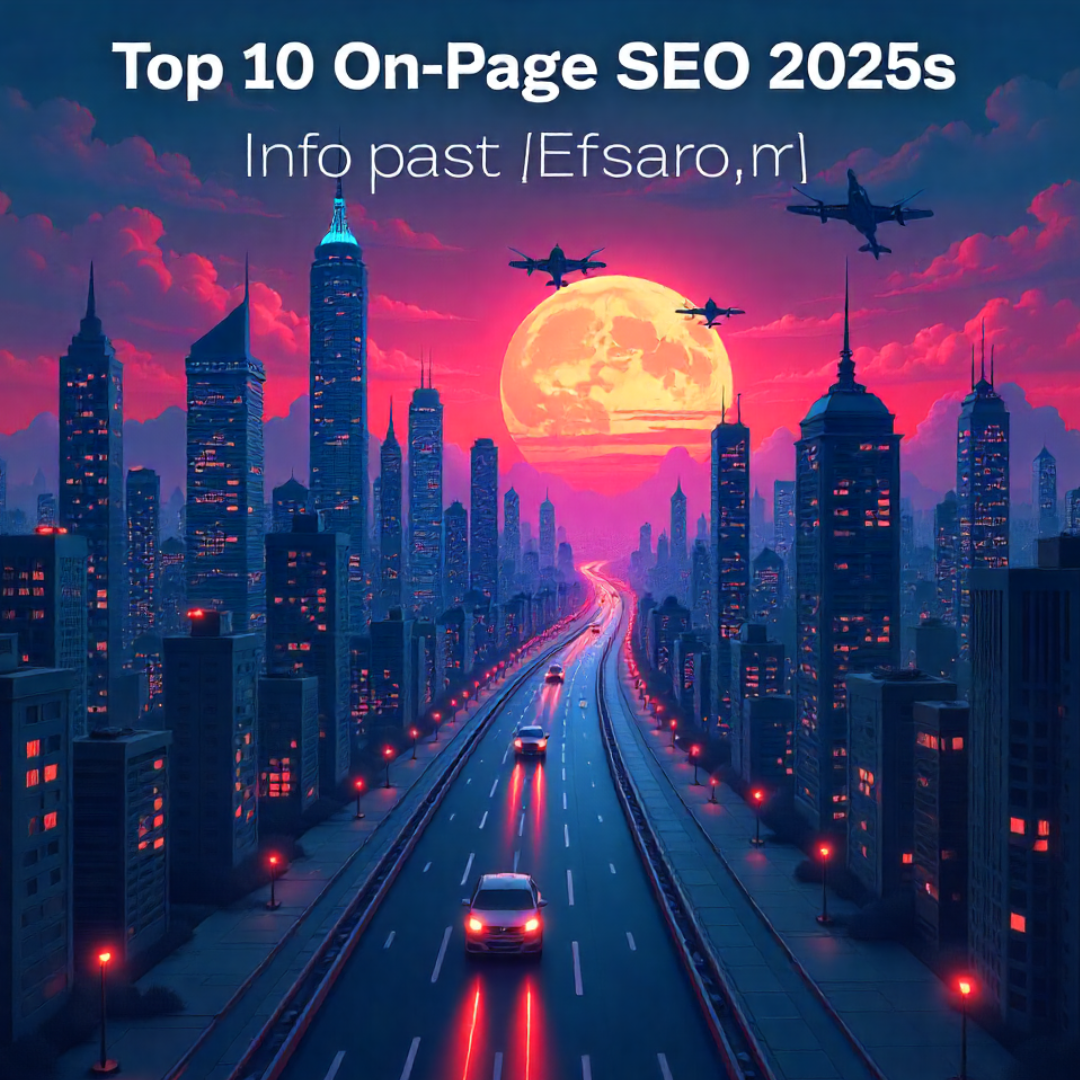Let’s be honest—SEO in 2025 is a whole different beast than it was a few years ago. It’s no longer about stuffing in a bunch of keywords and hoping for the best. Google’s gotten smarter. The way people search has changed. And your audience? They’ve got high expectations. If your website isn’t helpful, fast, and easy to navigate, they’re gone in a click.
The truth is, just having content on your site isn’t enough anymore. Everyone’s putting out blog posts. Everyone’s writing product descriptions. But what separates the good from the great—the stuff that actually ranks—is strategy. You don’t need to be an expert coder or spend thousands on tools. What you do need is a solid understanding of what’s working now—not five years ago. That’s why I’ve put together this list. These are the top 10 on-page SEO strategies that are making a real difference in 2025. Stuff that’s practical, effective, and built to last—no fluff, no hacks, just results.
So whether you’re running a blog, managing an eCommerce site, or building out a service-based business, these are the tools and tactics that’ll help your pages rise above the noise—and stay there.
1. Start with Intent-Driven Keywords
Let’s talk about real time SEO in 2025 it isn’t just about what people type into Google, it’s about why they’re searching in the first place. Search engines have gotten a lot smarter. They’re no longer just matching words, they're trying to understand the intention behind them. And if your content isn’t answering that deeper question, you’re gonna miss the mark—no matter how good your keywords are.
So instead of just chasing the biggest search terms you can find, slow down and ask yourself: What is this person actually trying to do? Are they ready to buy something? Are they just starting their research? Maybe they’re comparing a few options. Whatever it is, your content has to meet them right there—at that exact stage of their journey.
For example, instead of going after something broad like “best running shoes,” try dialing in a little deeper with something like “best cushioned running shoes for flat feet.” It’s more specific, it speaks directly to a problem someone is actively trying to solve, and it’s the kind of result that feels like exactly what they were looking for
Keyword Intent Optimization – A Skill for Career Strategy
| Step | Action | Tools You Can Use |
|---|---|---|
| 1 | Identify search intent — whether informational, transactional, navigational, or commercial. | Google Search, AnswerThePublic |
| 2 | Use long-tail keywords that align perfectly with the identified intent. | SEMrush, Ahrefs |
| 3 | Map each keyword to a specific page to avoid content cannibalization. | Google Sheets, Notion |
| 4 | Refresh and update old pages so they continue to match evolving user needs. | Screaming Frog, Surfer SEO |
At Skill for Career, our SEO and digital marketing courses teach you how to analyze search intent and target keywords that drive both traffic and conversions.
2. Craft Titles That Actually Get Clicked
Let’s be real—your headline is everything. You could have the best content on the internet, ranking on the first page of Google, but if your title doesn’t grab someone’s attention? They’re scrolling right past it.
In 2025, people are sharper than ever. They don’t just want information but they want emotion, curiosity and a clear benefit. Your headline needs to spark something. Maybe it makes them think, “Wait, what’s that about?” or “Hey, that could help me.” That kind of reaction is an aim.
But here’s the catch: it still needs to be honest. Skip the clickbait. If your headline promises something epic but the content doesn’t deliver, people won’t just bounce—they’ll remember not to trust you next time. So make your title punchy, clear, and actually tied to the value inside your post.
The goal? Make them want to click because it sounds helpful—not because you tricked them.
Title Tag Optimization – A Skill for Career Approach
| Step | Action | Tools You Can Use |
|---|---|---|
| 1 | Write 5–10 headline variations for each page or post before finalizing. | CoSchedule Headline Studio |
| 2 | Use power words or emotional triggers to capture attention. | Copy.ai, ChatGPT |
| 3 | Test click-through rates (CTR) with different titles over time. | Google Search Console |
| 4 | Keep titles under 60 characters to avoid search engine truncation. | SERPsim, Moz |
At Skill for Career, our digital marketing and SEO courses teach you how to craft title tags that grab attention, boost CTR, and perform well in search results.
3. Use Short, Structured URLs
Let’s be real—no one likes those long, messy URLs filled with random numbers or weird words. They just make things confusing. These days, keeping your URLs short and simple is the way to go.
Make sure your URLs are easy to read and include the main keywords without trying too hard. If you keep them under around 75 characters, it’s easier for people to know what your page is about — and Google loves that too.
Clean URLs just make life easier for everyone — visitors and search engines alike.
URL Structure Optimization – A Skill for Career Best Practice
| Step | Action | Tools You Can Use |
|---|---|---|
| 1 | Remove unnecessary stop words like a, the, and of for cleaner URLs. | Manual Edit |
| 2 | Add your focus keyword naturally in the URL for better SEO relevance. | Yoast SEO |
| 3 | Redirect outdated or messy URLs to their updated versions. | RankMath, Redirection Plugin |
| 4 | Maintain a simple URL structure reference to ensure consistency. | Notion, Google Docs |
At Skill for Career, our SEO courses teach you how to design clean, keyword-rich URLs that are easy for both users and search engines to understand.
4. Optimize Headers Like a Pro
Think of headers — H1, H2, H3 — as the signposts on your page. They don’t just make things look tidy; they actually help both your visitors and search engines understand what your content is all about.
Your main header, the H1, should grab attention and clearly say what the page covers. Then break up the rest with smaller headers that make it easy to scan and find info fast. Just make sure you mention your keywords in a way that flows naturally—no awkward stuffing.
Header Tag Optimization – A Skill for Career Method
| Step | Action | Tools You Can Use |
|---|---|---|
| 1 | Use only one H1 tag per page to define the main topic clearly. | WordPress, Webflow |
| 2 | Add relevant keywords naturally in H2 and H3 subheadings. | Surfer SEO, Clearscope |
| 3 | Treat headers as road signs that guide readers, not filler text. | Grammarly, Hemingway App |
| 4 | Maintain a logical hierarchy for all header tags. | Manual Audit, Screaming Frog |
At Skill for Career, our SEO and web development courses teach you the art of structuring content with header tags that improve both readability and search engine visibility.
5. Make Content Readable & Scannable
Honestly, nobody enjoys staring at a big chunk of text — it’s just too much and people usually click away. These days, making your content easy to read isn’t just for your visitors; search engines notice it too.
Keep your paragraphs short and to the point. Breaking things up with bullet points, and use bold or italics to call out the key bits. Write like you’re chatting with a buddy — clear, simple, and friendly — even if what you’re explaining is a little tricky.
Content Readability Optimization – A Skill for Career Approach
| Step | Action | Tools You Can Use |
|---|---|---|
| 1 | Write in short, punchy paragraphs to keep readers engaged. | Hemingway, Grammarly |
| 2 | Use bullet points, bold text, and quotes to break up large blocks of content. | Google Docs, Notion |
| 3 | Maintain a Flesch Reading Score above 60 for easy readability. | Readable.com |
| 4 | Add ample whitespace between sections for visual clarity. | CSS, Website Builder |
At Skill for Career, our content writing and digital marketing courses teach you how to create content that’s not only SEO-friendly but also enjoyable to read — keeping audiences hooked from start to finish.
6. Internal Linking = Big Wins
Internal links on your website are similar to useful arrows. They direct users to more helpful pages that complement the ones they are now seeing. People stay on your site and continue to explore instead of leaving. That's fantastic for them and the health of your website.
A lot of sites skip internal links, but they’re actually super simple and useful. Just think about where your visitors might want to go next, and link them there. It keeps things smooth and makes your site feel more connected..
Internal Linking Optimization – A Skill for Career Strategy
| Step | Action | Tools You Can Use |
|---|---|---|
| 1 | Link to 3–5 related articles within each post to guide readers and boost SEO. | LinkWhisper, Ahrefs |
| 2 | Use clear, descriptive anchor text so readers and search engines understand the link’s purpose. | Manual Edit |
| 3 | Organize your content into a hub-and-spoke structure for stronger topical authority. | Notion, Miro |
| 4 | Audit and update your internal links at least quarterly to maintain relevance. | Screaming Frog |
At Skill for Career, our SEO training includes internal linking strategies that improve site navigation, distribute link equity, and keep readers engaged longer.
7. Image SEO Is No Longer Optional
Images aren’t just for pretty design—they’re opportunities to rank. In 2025, every image should have an alt tag, compressed file size, and be optimized for loading speed.
Plus, visual search (like Google Lens) is on the rise. Don’t sleep on it.
Image SEO Optimization – A Skill for Career Guide
| Step | Action | Tools You Can Use |
|---|---|---|
| 1 | Use descriptive, keyword-rich filenames for your images before uploading. | Manual (before upload) |
| 2 | Add alt text with relevant keywords to improve accessibility and SEO. | WordPress, Shopify |
| 3 | Compress images to reduce file size without losing quality. | TinyPNG, ShortPixel |
| 4 | Use modern, lightweight formats like WebP or AVIF for faster loading. | Squoosh, Cloudinary |
At Skill for Career, we teach learners how to optimize every image for speed, accessibility, and search rankings — ensuring your visuals work as hard as your words.
8. Schema Markup Gives You the Edge
Adding schema won’t suddenly boost your rankings overnight, but it does make your listing pop out in search results. When your page shows extra stuff like star ratings or quick answers, people tend to trust it more and are more likely to click.
Just a small boost in visibility like this can bring in way more visitors and keep them engaged.
So, although schema isn’t some quick fix for SEO, it’s definitely a smart move if you want your site to look better and get noticed more often.
Schema Markup Optimization – A Skill for Career Approach
| Step | Action | Tools You Can Use |
|---|---|---|
| 1 | Add schema to blog posts, reviews, and FAQs to help search engines understand your content better. | RankMath, Yoast |
| 2 | Test your schema implementation to ensure eligibility for rich results. | Google’s Rich Results Tool, Google Search Console |
| 3 | Keep your schema code error-free for consistent search engine visibility. | Schema.org Validator |
| 4 | Update and refresh schema markup whenever content changes or at least quarterly. | Manual Updates |
9. Core Web Vitals Still Matter
You cannot ignore how your website feels to visitors. Google checks how fast your site loads and if it works smoothly. In 2025, if your site is slow or jumps around, people will leave—and Google won’t show your site at the top.
Even if your content is good but slow or confusing site is a big problem. It hurts your ranking and makes visitors loose trust. People want websites that are quick and easy to use. So, make sure your site works well if you want to keep visitors and rank better.
At Skill for Career, our web development and SEO courses teach you exactly how to measure, interpret, and improve Core Web Vitals — ensuring your site is not only search-engine-friendly but also lightning-fast for real users.
Core Web Vitals Optimization – A Skill for Career Guide
| Step | Action | Tools You Can Use |
|---|---|---|
| 1 | Check your LCP (Largest Contentful Paint), FID (First Input Delay), and CLS (Cumulative Layout Shift) scores to assess page performance. | PageSpeed Insights |
| 2 | Minimize unused CSS and JavaScript to speed up loading times. | Chrome DevTools, Asset CleanUp |
| 3 | Implement lazy loading for images so they load only when visible on the screen. | WordPress Plugins |
| 4 | Choose lightweight, mobile-first themes for better speed and responsiveness. | Astra, GeneratePress |
10. Regular Updates Win Long-Term
Content goes stale. Facts change. Links break. Google loves fresh, accurate content—especially for competitive keywords.
In 2025, updating your best-performing content is just as important as creating new stuff. Make it a monthly habi
Monthly On-Page SEO Maintenance Plan – Powered by Skill for Career
| Step | Action | Tools You Can Use |
|---|---|---|
| 1 | Revisit your top 10 performing pages every month to track trends and engagement. | Google Analytics, Google Search Console (GSC) |
| 2 | Update outdated stats, refresh links, and enhance visuals for a better user experience. | Grammarly, Canva |
| 3 | Add fresh insights, case studies, or FAQs to keep your content relevant. | Surfer SEO |
| 4 | Republish content with updated meta titles and descriptions for improved click-through rates. | WordPress |
At Skill for Career, we teach not just the theory but also the practical steps to maintain and improve your SEO strategy month after month.
Final Thoughts
On-page SEO isn’t just a checklist — it’s an ongoing relationship between you, your audience, and search engines. At Skill for Career, we believe that writing with intention, designing with care, and optimizing with precision not only helps you rank higher but also builds trust with real people. Just like our industry-focused courses empower learners to grow their skills, strong on-page SEO empowers your content to connect, engage, and stand out — not just for search engine robots, but for the humans who matter most.
⸻
Thanks & Regards,
Skill For Career Academy.
9220403922, 8860876087.
Enquiry@skillforcareer.com




